

A Plant Cells comparison to a Factory by Karan Mann on Prezi. La brillante erreur d'Einstein : les états intriqués - Chad Orzel. Miami Museum of Science-The pH Factor. Science of Cooking: Food Science, Recipes & Projects. RadTown USA. Nanoscale Science & Technology. An Interactive Periodic Table of the Elements. The Science Spot. Homework Help: Science for Kids. Science is the study of the world around us.
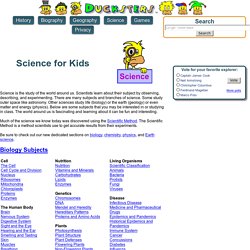
Scientists learn about their subject by observing, describing, and experimenting. There are many subjects and branches of science. Some study outer space like astronomy. Other sciences study life (biology) or the earth (geology) or even matter and energy (physics). Below are some subjects that you may be interested in or studying in class. Much of the science we know today was discovered using the Scientific Method. Be sure to check out our new dedicated sections on biology, chemistry, physics, and Earth science. Biology Subjects Chemistry Subjects Elements and the Periodic TableElementsPeriodic Table Earth Science Subjects Physics Subjects Be sure to check back often. Rader's CHEM4KIDS.COM - Chemistry basics for everyone! Science for Kids - Fun Experiments, Cool Facts, Online Games, Activities, Projects, Ideas, Technology.
Football physics: The "impossible" free kick - Erez Garty. If superpowers were real: Invisibility - Joy Lin. If superpowers were real: Super strength - Joy Lin. Awesome Science Teacher Resources. ScienceGeek.net Homepage. How playing an instrument benefits your brain - Anita Collins. How sugar affects the brain - Nicole Avena. Bioluminescence in the Gippsland Lakes. These pictures of bioluminescence in the Gippsland Lakes in my gallery have proven quite popular, so it seems time to provide a story to accompany them.

But this is not a short story, rather a convoluted one of fires and floods, of microscopic algae and the inspiring, remarkable and surprising beauty of nature. The story begins with alpine bushfires in Victoria, which started on 1st December 2006 when over 70 fires were started by a band of thunderstorms and lightning strikes which moved across the state.
This was an early start to the fire season following an extremely dry autumn and several years of drought conditions before that. Awesome ways To Start a Fire with Water. IBM Shrinks Computer Memory Into Only Twelve Atoms. Fantastic Fungi: The Forbidden Fruit. Plants can think and perform computations, say scientists. The Secret Language of Plants. Up in the northern Sierra Nevada, the ecologist Richard Karban is trying to learn an alien language.
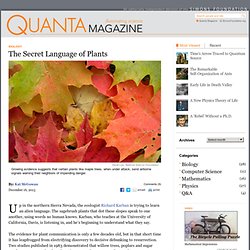
The sagebrush plants that dot these slopes speak to one another, using words no human knows. Karban, who teaches at the University of California, Davis, is listening in, and he’s beginning to understand what they say. The evidence for plant communication is only a few decades old, but in that short time it has leapfrogged from electrifying discovery to decisive debunking to resurrection. Two studies published in 1983 demonstrated that willow trees, poplars and sugar maples can warn each other about insect attacks: Intact, undamaged trees near ones that are infested with hungry bugs begin pumping out bug-repelling chemicals to ward off attack. They somehow know what their neighbors are experiencing, and react to it. Move over elephants: Mimosas have memories too. Not long after publishing a paper in a prestigious journal about plants being able to 'talk' using sound, Monica Gagliano is back with her new findings showing that they can 'learn'.
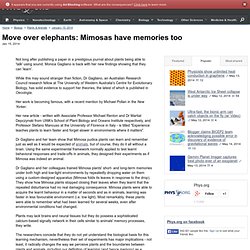
While this may sound stranger than fiction, Dr Gagliano, an Australian Research Council research fellow at The University of Western Australia's Centre for Evolutionary Biology, has solid evidence to support her theories, the latest of which is published in Oecologia. Her work is becoming famous, with a recent mention by Michael Pollan in the New Yorker. Her new article - written with Associate Professor Michael Renton and Dr Martial Depczynski from UWA's School of Plant Biology and Oceans Institute respectively, and Professor Stefano Mancuso at the University of Florence in Italy - is titled "Experience teaches plants to learn faster and forget slower in environments where it matters".
Explore further: Get touchy feely with plants. The smell of freshly-cut grass is actually a plant distress call. Green World "For in the true nature of things, if we rightly consider, every green tree is far more glorious than if it were made of gold and silver.
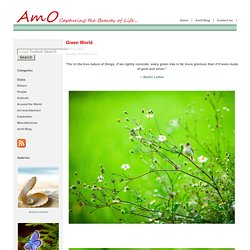
" ~ Martin Luther Photo Credit: GoodFon.ru. Why Do Some Clovers Have Four Leaves? Biology. History The objects of our research will be the different forms and manifestations of life, the conditions and laws under which these phenomena occur, and the causes through which they have been effected.

The science that concerns itself with these objects we will indicate by the name biology [Biologie] or the doctrine of life [Lebenslehre]. Although modern biology is a relatively recent development, sciences related to and included within it have been studied since ancient times. Natural philosophy was studied as early as the ancient civilizations of Mesopotamia, Egypt, the Indian subcontinent, and China. The Inner Life Of The Cell. The Human Cell Animation. XVIVO. In 2006, Harvard University teamed up with XVIVO to develop an animation that would take their cellular biology students on a journey through the microscopic world of a cell.
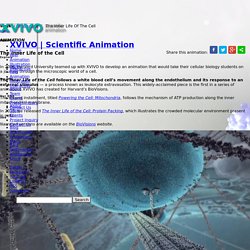
The Inner Life of the Cell follows a white blood cell’s movement along the endothelium and its response to an external stimulus — a process known as leukocyte extravasation. This widely-acclaimed piece is the first in a series of animations XVIVO has created for Harvard’s BioVisions. The second installment, titled Powering the Cell: Mitochondria, follows the mechanism of ATP production along the inner mitochondrial membrane. Cell as a Factory.